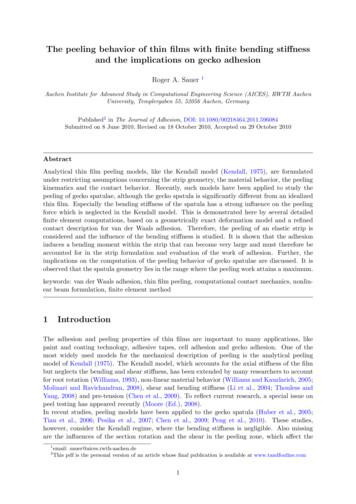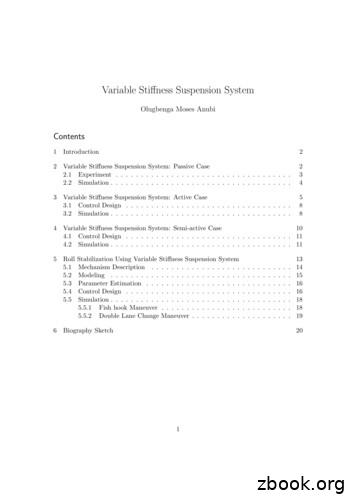The Matrix Stiffness Method For 2D Trusses
The Matrix Stiffness Method for 2D TrussesCEE 421L. Matrix Structural AnalysisDepartment of Civil and Environmental EngineeringDuke UniversityHenri P. GavinFall, 2014Method1. Number all of the nodes and all of the elements.2. Identify the Displacement Degrees of Freedom in Global Directions.Number all the structural degrees of freedom in your truss. In a 2D (planar) truss, eachnode can have a maximum of two degrees of freedom: one in the global X-directionand one in the global Y -direction. If a degree of freedom is restrained by a reaction,then it doesn’t get a number.3. Node Locations.Write the (x, y) coordinates of each node using units consistent with E and A. In otherwords, if E and A are given in kN/cm2 and cm2 , write the (x, y) coordinates in termsof centimeters.4. Define each element.Draw each element of your truss individually and draw the local coordinates in theglobal directions. For example if element number N is a diagonal truss element, andthe global directions are X: horizontal and Y: vertical, draw element number N likethis:4Bar Direction32(x , y )21Local Joint Number22θ1Element Coordinatein Global Directions11(x , y )11where 1,2,3,4 are the element coordinates of the truss element in the global directions.The local coordinates are always numbered 1,2,3,4 with 1 and 3 pointing in the globalX direction (to the right) and with 2 and 4 pointing in the global Y direction (up).Some or all of these four coordinates will line up with with the structural degrees offreedom that you identified in step 2., above. The angle θ is the counter-clockwise anglefrom element coordinate 1 to the truss element.
2CEE 421L. Matrix Structural Analysis – Duke University – Fall 2014 – H.P. Gavin5. Element Stiffness Matrices in Global Coordinates, K.For each element, find its (4x4) element stiffness matrix, by evaluating the equationsbelow:qL (x2 x1 )2 (y2 y1 )2c (x2 x1 )/Ls (y2 y1 )/L K EA L c2cs c2 cscss2 cs s2 . c2 csc2cs cs s2css2 or by using the truss 2d element.m script in matlab. You should understand wherethese equations come from, why this matrix is symmetric, why the diagonal terms areall positive, and what the off-diagonal terms mean.6. Structural Stiffness Matrix, Ks .The structural stiffness matrix is a square, symmetric matrix with dimension equal tothe number of degrees of freedom. In this step we will fill up the structural stiffnessmatrix using terms from the element stiffness matrices in global coordinates (from step5.) This procedure is called matrix assembly.Recall from step 4. how the element degrees of freedom (1,2,3,4) line up with the structural degrees of freedom in your problem. For example, coordinates (1,2,3,4) might lineup with degrees of freedom (3,4,7,8) of the truss. In this case, to assemble this elementinto the structural stiffness matrix,K(1,1) Ks(3,3) K(1,2) Ks(3,4) K(1,3) Ks(3,7) K(1,4) Ks(3,8)------------------ ------------------- ------------------- -----------------K(2,1) Ks(4,3) K(2,2) Ks(4,4) K(2,3) Ks(4,7) K(2,4) Ks(4,8)------------------ ------------------- ------------------- -----------------K(3,1) Ks(7,3) K(3,2) Ks(7,4) K(3,3) Ks(7,7) K(3,4) Ks(7,8)------------------ ------------------- ------------------- -----------------K(4,1) Ks(8,3) K(4,2) Ks(8,4) K(4,3) Ks(8,7) K(4,4) Ks(8,8)where the is short-hand for “is added to” . K(1,3) is added to Ks(3,7).Add each element into the structural stiffness matrix in this way to get Ks . Note that ifone end of the truss element is fully restrained in both the the X- and Y - directions, youwill need to place only four of the sixteen terms of the element’s 4x4 stiffness matrix.7. Forces, p.Create the force vector p, by finding the components of each applied force in thedirections of the global degrees of freedom. Create the force vector by placing theseforce components into the force vector at the proper coordinates.CC BY-NC-ND H.P. Gavin
3The Matrix Stiffness Method for 2D Trusses8. Deflections, d.Find the deflections by inverting the stiffness matrix and multiplying it by the loadvector. You can do this easily in matlab: d Ks \ p9. Internal bar forces, T .Again, recall how the global degrees of freedom line up with each element’s coordinates(1,2,3,4). For example, in element number N from step 6., the local element deflectionsin the global directions, v1 , v2 , v3 , v4 line up with the structural deflections deflectionsd3 , d4 , d7 , d8 . The internal bar forces can be computed from:T EAEA[(v3 v1 )c (v4 v2 )s] [(d7 d3 )c (d8 d4 )s]LLwhere c and s are the direction cosine and sine for the element from step 5.You should be able to derive this equation.Knowing what each bar force is, the reactions can be easily computed with equilibriumequations.Notationuqk T v f K dpKs Element deflection vector in the Local coordinate systemElement force vector in the Local coordinate systemElement stiffness matrix in the Local coordinate system. q k uCoordinate Transformation Matrix (orthonormal). T 1 TTElement deflection vector in the Global coordinate system. u T vElement force vector in the Global coordinate system. q T fElement stiffness matrix in the Global coordinate system. K TT k TStructural deflection vector in the Global coordinate systemStructural load vector in the Global coordinate systemStructural stiffness matrix in the Global coordinate system. p Ks dCoordinate SystemElement DeflectionElement ForceElement StiffnessStructural DeflectionStructural LoadsStructural StiffnessLocaluqk-GlobalvfKdpKsCC BY-NC-ND H.P. Gavin
4CEE 421L. Matrix Structural Analysis – Duke University – Fall 2014 – H.P. GavinExampleY4E 30,000 k/sq.in.6354A 10 sq.in.50 k3512 ft.63121852472X1100 k16 ft.1Global Joint Number2Bar Number16 ft.System Equation: {f} [K}{d}Bar Direction11Structural Degree of Freedom{d} : displacement vector { d1 d2 d3 d4 d5 d6 }’Applied Force{f} : load vector { 0 100 0 0 50 0 }’4Local Joint Number21Local Degree of Freedom3Global Coordinate System12θElement Coordinates in Global Directions1CC BY-NC-ND H.P. Gavin
5The Matrix Stiffness Method for 2D Trussesfunction [ K, L ] truss 2d element ( x1, y1, x2, y2, EA )% [ K, L ] TRUSS ELEMENT 2D ( X1, Y1, X2, Y2, EA, T )% Compute the element stiffness matrix for a 2D truss bar in global coordinates%% INPUT DATA:%X1,Y1is the location of joint 1 of the truss bar%X2,Y2is the location of joint 2 of the truss bar%EAis the product of the elastic modulus and the section area%% OUTPUT DATA:%Kis the 4x4 truss bar element stiffness matrix in global element coord’s%Lis the length of the truss barL sqrt( (x2-x1)ˆ2 (y2-y1)ˆ2 );% length of the barc ( x2 - x1 ) / L;s ( y2 - y1 ) / L;K (EA/L) * format bankE 3e4;A 10;EA E*A;% cosine of bar angle%sine of bar angle[ cˆ2c*s -cˆ2 -c*s ;c*ssˆ2 -c*s -sˆ2 ;-cˆ2 -c*scˆ2c*s ;-c*s -sˆ2c*ssˆ2 ];% ------- TRUSS ELEMENT 2D% two decimal places after the .% modulus of elasticity% area of cross section [ K1, L(1) ] truss 2d element( 0, 0, 12*16, 12*12, EA )K1 0.00 [ K2, L(2) ] truss 2d element( 0, 0, 12*16, 0, EA )K2 1562.500.000.000.00-1562.500.00% truss element 1% truss element 20.000.00CC BY-NC-ND H.P. Gavin
6CEE 421L. Matrix Structural Analysis – Duke University – Fall 2014 – H.P. Gavin-1562.500.000.000.001562.500.000.000.00 [ K3, L(3) ] truss 2d element( 12*16, 0, 12*16, 12*12, EA )K3 00.000.00-2083.330.002083.33 [ K4, L(4) ] truss 2d element( 12*16, 12*12, 12*32, 12*12, EA )K4 00.00% truss element 6-600.00-450.00600.00450.00 [ K7, L(7) ] truss 2d element( 12*16, 0, 12*32, 0, EA )K7 1562.500.00-1562.500.00% truss element 5600.00-450.00-600.00450.00 [ K6, L(6) ] truss 2d element( 12*16, 0, 12*32, 12*12, EA )K6 800.00600.00-800.00-600.00% truss element 40.000.000.000.00 [ K5, L(5) ] truss 2d element( 12*16, 12*12, 12*32, 0, EA )K5 800.00-600.00-800.00600.00% truss element 3% truss element 70.000.000.000.00CC BY-NC-ND H.P. Gavin
7The Matrix Stiffness Method for 2D Trusses [ K8, L(8) ] truss 2d element( 12*32, 0, 12*32, 12*12, EA )K8 00.00% 3assemble the global structural stiffness matrix . Ks [ 392560000-800-600 600 2533.330-2083.33 -600-450 003162.50-1562.50 0 -2083.3302983.3300 -800 -600-1562.502362.5 600 -600 -450006002533.33;;;;;]Ks .002533.33 find(Ks-Ks’)ans [](0x0)% truss element 8% check to see if Ks is symmetric .% It is! p [ 0 -100 0 0 50 0 ]’% input the load vectorp 0.00-100.000.00CC BY-NC-ND H.P. Gavin
8CEE 421L. Matrix Structural Analysis – Duke University – Fall 2014 – H.P. Gavin0.0050.000.00 format% change formats for more sig. fig’s d Ks \ p% compute the joint displacementsd 0164325CC BY-NC-ND H.P. Gavin
The Matrix Stiffness Method for 2D Trusses 3 8.Deflections, d. Find the deflections by inverting the stiffness matrix and multiplying it by the load vector. You can do this easily in matlab: d Ks \ p 9.Internal
STI-AS STI-VS SKS STI Certificate Requests Private Key(s) Private Key(s) List of Trusted STI-CAs Service Provider Code Token Requests CRTC: Canadian Radio-television and Telecommunications Commission CST -GA: Canadian Secure Token Governance Authority STI-PA: STI-Policy Administrator STI-CA: STI-Certification Authority STI-CR: STI-Certificate .
May 02, 2018 · D. Program Evaluation ͟The organization has provided a description of the framework for how each program will be evaluated. The framework should include all the elements below: ͟The evaluation methods are cost-effective for the organization ͟Quantitative and qualitative data is being collected (at Basics tier, data collection must have begun)
Silat is a combative art of self-defense and survival rooted from Matay archipelago. It was traced at thé early of Langkasuka Kingdom (2nd century CE) till thé reign of Melaka (Malaysia) Sultanate era (13th century). Silat has now evolved to become part of social culture and tradition with thé appearance of a fine physical and spiritual .
To extend previous sti ness reduction approaches, a sti ness reduction method is pre-sented herein that utilises more advanced sti ness reduction functions to capture fully the detrimental in uence of the spread of plasticity, residual stresses and geometrical imperfec-tions on the capacity of columns and beam-columns.
The Tables 3 represents the comparisons of results of sti ness obtained from analysis investigations. Table 3 E ect of Sti ness for model frame iii) Percentage Increase in Lateral Sti ness The Percentage increase in lateral sti ness for varying in ll heights for di erent models is shown in the Figure 4.
The Kendall model, which accounts for the axial sti ness of the lm but neglects the bending and shear sti ness, has been extended by many researchers to account for root rotation (Williams,1993), non-linear material behavior (Williams and Kauzlarich,2005; Molinari and Ravichandran,2008), shear and bending sti ness (Li et al.,2004;Thouless and
sti ness and the passive variable sti ness cases. For the constant sti ness case, the con-trol mass was locked at three di erent locations (d 40cm;d 45:56cmand d 50cm). The value d 45:56cmis the equilibrium position of the control mass. Next, a simu-lation was performed for the passive case. The results obtained are shown in Figures
On an exceptional basis, Member States may request UNESCO to provide thé candidates with access to thé platform so they can complète thé form by themselves. Thèse requests must be addressed to esd rize unesco. or by 15 A ril 2021 UNESCO will provide thé nomineewith accessto thé platform via their émail address.























